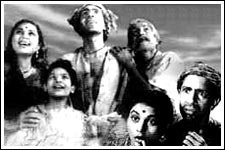
HOME | MOVIES | FEEDBACK |

Dinesh Raheja
Recipient of a special mention at Cannes, winner of the social progress award at Karlovy Vary, and awarded Best Film trophy at the very first Filmfare Awards, Do Bigha Zameen has become a cinematic reference point.
Renowned auteur Bimal Roy's first Hindi film to make a seismic impact, it is one of the earliest Hindi films to bridge the art-commerce chasm.
This gritty tale of an impoverished farmer's struggle to retain his land is realistic and set in a deromanticised rural-urban dystopia. But it is also highly dramatic (if a bit too sentimental) in its narration.
For Do Bigha Zameen, he chose a stark subject, eschewed stars and made his cast wear realistically worn out clothes. He imbued the film with overwhelming poignancy.
The film opens with images of a parched earth and barren trees. The country has just suffered a two-year draught. The rains have skinny, bare-chested farmer Shambu Mahato (Balraj Sahni) delighting with his wife Paro (Nirupa Roy) and son Kanhaiya (Rattan Kumar), in the genesis of hope that comes with the rains.
This portion evokes a blissfully bucolic air --- utensils are carefully placed to catch water from a leaking roof, boys eagerly lean over a well to gauge the water level and Kanhaiya is let off from school early because the master's cows have wandered off.
But Shambhu has more reasons to crease his brow than the vagaries of inclement weather. The zamindar (Sapru) wants to construct a factory and needs to merge Shambu's little two-acre plot into his land. Under the pretext of an old loan the unlettered Shambhu had taken, he creates a situation where either Shambhu has to return the loan within two months or lose his land.
Tearing himself away from his beloved wife, Shambhu goes to Kolkata to earn the money. Kanhaiya hides as a stowaway on the train and lands in the alien city. After some generic adventures that beset villagers in a big city, they find refuge with a megaphone-mouthed, but large-hearted, female landlord. Shambhu learns to ply a hand-pulled rickshaw.
With heartbreaking intensity, the entire family tries to accumulate the money. Shambhu even injures himself when he is egged on to push himself to the outer limits of endurance in an inhuman race between two rickshaws started by two lovers who have had a spat. Paro wades into deep water to collect vegetables and earn some coppers and even works as a construction labourer.
The film's moral issues are largely played out by Kanhaiya who steals when his boot polisher job is snatched. He repents but the torpid reality of their lives refuses to change. When Paro comes to the city and is involved in an accident, they use their money to save her life.
The film ends with the family returning to their land only to witness a factory already standing on their do bigha zameen, the chimney's black smoke, literally and figuratively, blowing away their hopes.
They may have lost their do bigha zameen, but what I find touching is that they retain their humanity in a harsh world.
Do Bigha Zameen can be seen as the metaphor for the protagonist's ability to live a life of his choice --- which is denied to him both in the village as well as the city.
The film is highly cinematic in its evocative images which are more powerful than some of its lines --- the last shot, the rains on the fields and the loving, lingering shots of the many faces of Kolkata.
Balraj Sahni's towering perfromance is the pivot around which the film moves. Despite being urban and educated he certainly looks the part. He worked alongside real rickshaw pullers to practise their skill as son Parikshit and his sister sat in the rickshaw.
Nirupa Roy bought clothes from Mumbai's Chor Bazaar to wear in the film. Roy wouldn't let her wash them. When Roy expressed surprise at her fitting so well into the rustic role, she pertly reminded him that she was from Bulsar village, Gujarat. This often undervalued actress tackles her part with understanding and understatement.
Sidelights:
* Though he was almost 40 when he did the film, struggling actor Balraj Sahni became a respected name and celebrated thespian. Trilok Kapoor, Jairaj, even Nasir Hussain were some of the names considered for the role till Roy saw Sahni in the dark yet reasonably successful Hum Log (1951).
* Nirupa Roy was famous as a screen goddess in countless mythologicals. The film made her a star in socials as well. Balraj and Nirupa went on to do a dozen odd films including some experimental fare like Garm Coat and Heera Moti (based on Hindi novelist Munshi Premchand's story).
* Bimal Roy made the critically acclaimed Hamrahi in 1945. But Do Bigha Zameen gave his career a tremendous impetus and kicked off the most creatively fertile decade (1953-1963) of his life.
* Meena Kumari makes a special appearance in the film with the lullaby, Aa ja ri aa. She was working with Roy in Parineeta when she saw the stills of Do Bigha Zameen and expressed a desire to be part of the film.
The Music:
* For his story Rickshawala, Salil Chowdhary asked to compose the film's score too. Thus began his career in Hindi films (which includes classics like Madhumati and Anand).
In the background score, Chowdhary effectively uses Western instruments to evoke the plaintive mood.
You might also want to read:
|
||
© 1996 - 2002 rediff.com India Limited. All Rights Reserved. |
|||